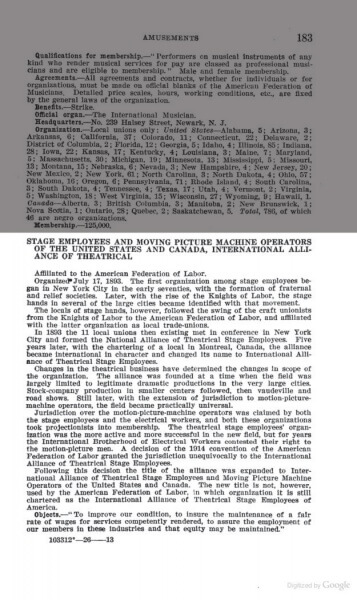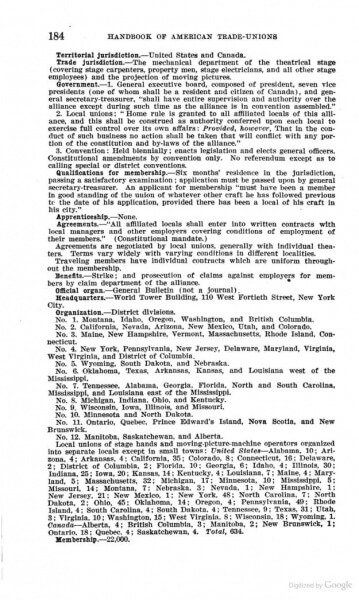| Artifact Type | Government Publications, Sources |
| Publication | Handbook of American Trade-Unions 1926 |
| Number | 420 |
| Page Number | 183–184 |
| Place | Washington, D.C. |
| Publication Date | October 1926 |
| Transcript | Show/Hide |
|
Headline: “Stage Employees and Moving Picture Machine Operators of the United States and Canada, International Alliance of Theatrical” Affiliated to the American Federation of Labor. Organized July 17, 1893. The first organization among stage employees began in New York City in the early seventies, with the formation of fraternal and relief societies. Later, with the rise of the Knights of Labor, the stage hands in several of the large cities became identified with that movement. The locals of stage hands, however, followed the swing of the craft unionists from the Knights of Labor to the American Federation of Labor, and affiliated with the latter organization as local trade-unions. In 1893 the 11 local unions then existing met in conference in New York City and formed the National Alliance of Theatrical Stage Employees. Five years later, with the chartering of a local in Montreal, Canada, the alliance became International In character and changed Its name to International Alliance of Theatrical Stage Employees. Changes In the theatrical business have determined the changes In scope of the organization. The alliance was founded at a time when the field was largely limited to legitimate dramatic productions in the very large cities. Stock-company production in smaller centers followed, then vaudeville and road shows. Still later, with the extension of jurisdiction to motion-picture-machine operators, the field became practically universal. Jurisdiction over the motion-picture-machine operators was claimed by both the stage employees and the electrical workers, and both these organizations took projectionists Into membership. The theatrical stage employees’ organization was the more active and more successful In the new field, but for years the International Brotherhood of Electrical Workers contested their right to the motion-picture men. A decision of the 1914 convention of the American Federation of Labor granted the jurisdiction unequivocally to the International Alliance of Theatrical Stage Employees. Following this decision the title of the alliance was expanded to International Alliance of Theatrical Stage Employees and Moving Picture Machine Operators of the United States and Canada. The new title is not, however, used by the American Federation of Labor, in which organization it is still chartered as the International Alliance of Theatrical Stage Employees of America. Objects. — “To improve our condition, to insure the maintenance of a fair rate of wages for services competently rendered, to assure the employment of our members in these Industries and that equity may be maintained.” Territorial jurisdiction. — United States and Canada. Trade jurisdiction. — The mechanical department of the theatrical stage (covering stage carpenters, property men, stage electricians, and all other stage employees) and the projection of moving pictures. Government. — 1. General executive board, composed of president, seven vice presidents (one of whom shall be a resident and citizen of Canada), and general secretary-treasurer, “shall have entire supervision and authority over the alliance except during such time as the alliance is in convention assembled.” 2. Local unions : ” Home rule is granted to all affiliated locals of this alliance, and this shall be construed as authority conferred upon each local to exercise full control over its own affairs : Provided, hoicevcr, That in the conduct of such business no action shall be taken that will conflict with any portion of the constitution and by-laws of the alliance.” 3. Convention : Held biennially ; enacts legislation and elects general officers. Constitutional amendments by convention only. No referendum except as to calling special or district conventions. Qualifications for membership. — Six months’ residence in the jurisdiction, passing a satisfactory examination ; application must be passed upon by general secretary-treasurer. An applicant for membership “must have been a member in good standing of the union of whatever other craft he has followed previous to the date of his application, provided there has been a local of his craft In his city.” Apprenticeship. — None. Agreements. — “All affiliated locals shall enter into written contracts with local managers and other employers covering conditions of employment of their members.” (Constitutional mandate.) Agreements are negotiated by local unions, generally with individual theaters. Terms vary widely with varying conditions in different localities. Traveling members have individual contracts which are uniform throughout the membership. Benefits. — Strike; and prosecution of claims against employers for members by claim department of the alliance. Official organ.— General Bulletin (not a journal). Headquarters.— World Tower Building, 110 West Fortieth Street, New York City. Organization.— District divisions. No. 1. Montana, Idaho, Oregon, Washington, and British Columbia. No. 4. New York, Pennsylvania, New Jersey, Delaware, Maryland, Virginia, West Virginia, and District of Columbia. No. 5. Wyoming, South Dakota, and Nebraska. No. 6. Oklahoma, Texas, Arkansas, Kansas, and Louisiana west of the Mississippi. No. 7. Tennessee, Alabama, Georgia. Florida, North and South Carolina, Mississippi, and Louisiana east of the Mississippi. No. 11. Ontario, Quebec, Prince Edward’s Island, Nova Scotia, and New Brunswick. No. 12. Manitoba, Saskatchewan, and Alberta. Local unions of stage hands and moving-picture-machine operators organized into separate locals except in small towns: United States — Alabama, 10; Arizona, 4; Arkansas, 4; California, 35; Colorado, 8; Connecticut, 16; Delaware, 2; District of Columbia, 2; Florida. 10; Georgia, 6; Idaho, 4; Illinois, 30; Indiana, 25 ; Iowa, 20 ; Kansas, 14 ; Kentucky, 4 ; Louisiana, 7 ; Maine, 4 ; Maryland, 5; Massachusetts, 32; Michigan, 17; Minnesota, 10; Mississippi, 5; Missouri, 14; Montana, 7: Nebraska. 3; Nevada, 1; New Hampshire, 1; New Jersey, 21; New Mexico, 1; New York, 48; North Carolina, 7; North Dakota, 2; Ohio, 45; Oklahoma, 14; Oregon, 4; Pennsylvania, 49; Rhode Island, 4 ; South Carolina, 4 ; South Dakota, 4 ; Tennessee, 9 ; Texas, 31 ; Utah, 3; Virginia, 10; Washington, 15; West Virginia, 8; Wisconsin, 18; Wyoming, 1. Canada — Alberta, 4; British Columbia, 3; Manitoba, 2; New Brunswick, 1; Ontario, 18; Quebec, 4; Saskatchewan, 4. Total, 634. Membership.— 22,000. |
|
| Archive | The Internet Archive |
| Read In Context | https://archive.org/stream/bub_gb_sng7tAtSf3MC#page/n193/mode/2up |
| Citation | Estelle M. Stewart, “Stage Employees and Moving Picture Machine Operators of the United States and Canada, International Alliance of Theatrical,” Handbook of American Trade-Unions 1926, October 1926. |
| Tags | 1920s1926 |

